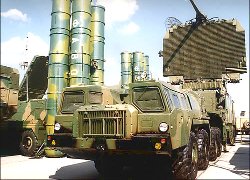Belarusian companies are serving Iran and Syria’s air defense
42- 19.11.2012, 10:06

Belarusian enterprises are assisting a number of Middle East countries in modernizing the air defense equipment.
In the height of discussions in the West about a possible air strike at Iranian nuclear facilities, there are messages in the local media that the country is enforcing the strength of its air defense, the BelaPAN’s military observer Aliaksandr Alesin writes.
As an Iranian news agency Pars has recently reported referring to the commander of the air defense military base Khatam ol-Anbia brigadier general Farzasad Esmayili, the specialists have reached great success in modernizing the anti-aircraft missile systems S-200 with which the Iranian air defense is equipped.
We would note that Tehran has purchased around ten S-200VE Vega-E of Soviet engineering backin the end of 1980-ies – beginning of 1990-ies.
Earlier, in July 2011, Esmayili told journalists, that the Iranian variant of the system overwhelmed Russian experts. And the testing carried out in November confirmed the tactic and technical characteristics stated in the program of modernization.
In the context it is probably worth reminding that the anti-aircraft missile systems S-200 is a long-range system of missiles. In every division there are six launchers with a single-rail runner (for a single missile) and a radiolocation station of fire management and also a trail of supporting machines.
Every missile is equipped with four solid-rocket boosters which are place at the body of the cruise engine. The maximum range that it reaches is 200-350 km depending on the version.
In the instrument complex of the missile there is equipment that ensures radio correction at the middle section of the trajectory and s semi-active radiolocation target seeker warhead, which is active in the final section of the trajectory.
These anti-aircraft missile systems were developed in the 1970-ies specially for fighting strategic and remote bomber planes, airborne early warning and control and other similar targets. However even now not they pose a serious threat for the aviation of a potential enemy, especially after having been modernized. That is admitted by NATO experts as well.
According to some information, the effectiveness and interference protection of the S-200 were proven in the course of the US’ operation against Libya “Fire in the prairie” (1986) and a bit earlier in Syria (1982).
In the meanwhile a number of experts in air defense (including Russian ones) are sure that Iranians are not capable of modernizing such a complex weapon system themselves, improving its combat and operational properties. It could have hardly been done without the assistance of specialists from the former Soviet republics.
Some analysts name the private Belarusian enterprise Tetrahedron, founded in 2001 and specializing in modernization of Soviet anti-aircraft complexes, as a possible developer and executor of the S-200 modernization program. The enterprise has a license allowing independent foreign trade along the lines of military and technical cooperation of Belarus with foreign states.
The Tetrahedron’s modernization programs are mainly connected with the application of two methods of aiming for anti-aircraft guided missiles developed by the company. Introduction of these methods does not require any significant hardware debugging and only the algorithms for command generation are altered.
By the way, back in 2003 the Tetrahedron did overpatching for S-200 Vega for Belarusian military.
Now this company is offering modernization of the anti-aircraft S-200VE via introduction of the equipment developed in the basis of the latest achievements in the sphere of signal processing, digital techniques and newest technologies. At the same time the overmatching of S-200 can be carried out in the places of a client’s permanent location.
Apart from that the enterprise has technical capabilities for maintenance, recovery and overhaul-period renewal for anti-aircraft 5V28E, which are used for S-200VE.
Speaking about modernization according to such a project, analysts, apart from Iran name North Korea and Syria –countries having S-200VE in the inventory - as potential Tetrahedron’s clients. Syria must be especially interested in upgrading its far-reaching anti-aircraft facilities (there are around eight of those) as lately calls for external intervention into the Syrian conflict have been being voiced more and more often.
By the way, Tetrahedron is capable of helping Damascus to modernize the old Soviet anti-aircraft systems S-125 Neva and S-125M Pechora (the Syrians have around 60 of those according to some estimations). The company offers not a fundamental but a simplified (and respectively a cheaper) but at the same time very effective program of modernization, based on development of a new missile aiming system (the missile itself remains the same 5V27).
On account of such modernization the likelihood of a missile impact significantly increases, the damage area increases from 25 to 35 km, the missile guidance station becomes dual-link. An improved complex is capable of hitting modern small scale targets and air targets flying with the speed 900 m/s against 700 m/s as it was with the original anti-aircraft system S125.
The cost of modernization of S-125 according to that program, named Pechora-2T, is the lowest on the market and according to estimations costs only a million dollars for a complex.
The Tetrahedron, in experts’ opinion, is not the only Belarusian enterprise, working for the Middle East market for Soviet air defense modernization services. Some specialists assume that the recent upgrade of 48 Syrian anti-aircraft systems Buk was carried out with the assistance of the Belarusian enterprise Alevkurp. It is one of the developers of the modernization program for anti-aircraft systems Buk – Buk-MB.









